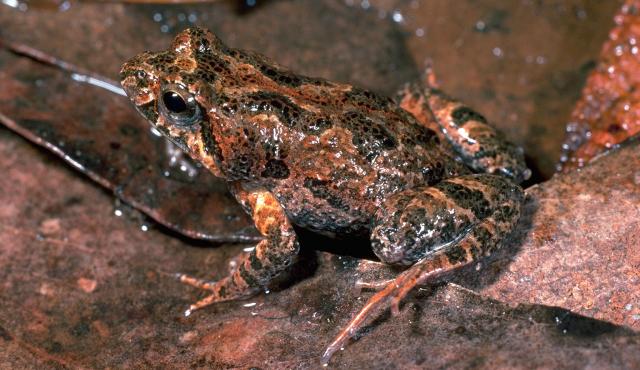A range of teacher professional learning programs will be developed to accompany the Biodiversity of the Western Volcanic Plains online outreach...

Eastern Sign-bearing Froglet
Crinia parinsignifera
Breeding season: late summer to autumn after heavy rainfall. Females lay 70-170 pigmented eggs in loose clumps, often coated in soil in a shallow burrow constructed by the male. The burrows will become flooded with winter rain. Males guard the eggs. A ground dwelling species which tends to walk rather than hop.
| Details | Description |
| Type | Amphibian |
| Group | Frog - Southern Frog |
| Former Scientific Name | Ranidella parinsignifera |
| Other Common Names | Plains Froglet |
| Identifying Characteristics | |
| Distinctive Markings | Adults have a granular ventral surface, generally light grey or off-white with scattered dark markings. Slightly pointed snout and indistinct tympanum. |
| Diet | Carnivore. Adults feed on invertebrates. |
| Habitat | Under logs, rocks and debris in moist depressions or near water in woodlands, floodplains, open and disturbed areas. |
| Native Status | Native to Australia |
| Sounds | The identifying call is a long harsh repeating "eeeeeeeek". |
| Taxonomy | |
| Phylum | Chordata |
| Class | Amphibia |
| Order | Anura |
| Family | Myobatrachidae |
| Genus | Crinia |
| Species | parinsignifera |

Distribution maps indicate current and historic locations where species have been sighted.
Source: Atlas of Living Australia
| Conservation Status | |
| DEPI Advisory List | Not listed |
| FFG Act | Not listed |
| EPBC Act | Not listed |
The conservation status of species is listed within Victoria and Australia.
The Department of Environment and Primary Industry (DEPI) Advisory List consists of non-statutory advisory lists of rare or threatened flora and fauna within Victoria.
The Flora and Fauna Guarantee Act 1988 (FFG Act) lists threatened species in Victoria. Under the Act, an Action Statement is produced for each listed species.
The Environment Protection and Biodiversity Conservation Act 1999 (EPBC Act) is the Australian Government’s key piece of environmental legislation, listing nationally threatened native species and ecological communities.



